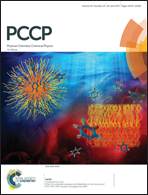Model membrane size-dependent amyloidogenesis of Alzheimer's amyloid-β peptides†
Abstract
We herein report the mechanism of amyloid formation of amyloid-β (Aβ) peptides on small (SUV) and large unilamellar vesicles (LUVs), which consist of 1-palmitoyl-2-oleoyl-sn-glycero-3-phosphocholine (POPC) lipids. Although Aβ1–42 formed fibrils on SUVs at all POPC concentrations used, the lag time, elongation rate, maximum thioflavin T intensity, and fibrillar morphology were distinct, indicating polymorphic amyloid formation. LUVs, at low POPC concentrations, did not markedly affect fibrillation kinetics; however, increases in POPC concentrations suppressed amyloid formation. No significant differences in the thermal stabilities of Aβ1–42 fibrils formed with and without vesicles were observed, although fibrils formed on SUVs showed some differences with dilution. SUVs markedly promoted Aβ1–40 fibrillation by condensing Aβ1–40, whereas no effects of LUVs on amyloidogenesis were detected. Salts greatly increased Aβ1–40 amyloidogenicity on vesicles. We proposed comprehensive models for vesicle size-dependent Aβ amyloidogenesis. Inhomogeneous packing defects in SUVs may induce distinct nucleation in the polymorphisms of amyloids and decreasing local concentrations of Aβ with higher amounts of LUVs inhibits amyloid formation. We also pointed out that C-terminal hydrophobicity of Aβ is important for amyloidogenesis on membranes.



 Please wait while we load your content...
Please wait while we load your content...